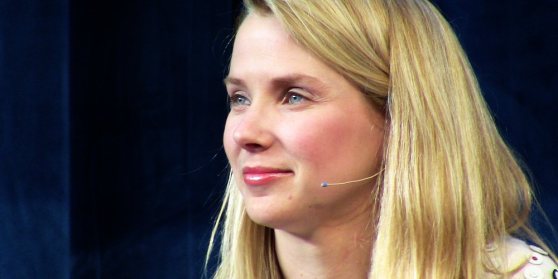LAS VEGAS — At some point in 2014, Yahoo will have a mobile crossover event. That is, the non-Tumblr Yahoo products will have more active users on mobile than on desktop.
Right now, Yahoo’s homegrown products bring in 800 million monthly active users (MAUs). And 400 million of those MAUs come from mobile devices.
The crossover will be the culmination of CEO Marissa Mayer’s leadership since she took control in mid-2012 and prophesied that Yahoo’s future was going to be mobile.
“It’s been a bit of a journey,” said Yahoo mobile SVP Adam Cahan in an interview at CES.
“Marissa made that statement [that Yahoo would be mobile-first] about 14 months ago.” At that time, he said, “Literally 50 people were working on mobile.”
The strategy
When Facebook encountered similar issues at the beginning of the smartphone era, it chose to retrain its non-mobile developers and integrate its existing mobile dev employees into every department of the company.
Yahoo took a different approach based on acquisitions. Instead of retraining the old guard, Mayer put into action a huge push to acquire the best technology and talent the mobile world could offer.
“We closed out 2013 with acquiring 31 companies,” said Cahan.
“We focused on acquihiring. You literally cannot interview enough people to grow fast enough. So you acquire teams and they start bringing in their friends.”
And Cahan also said Yahoo hasn’t had problems keeping the folks it hires through such deals, largely because of the energy and enthusiasm around Mayer’s reinvention strategy.
“Retention — We haven’t had an issue,” he said.
“When we acquire a team, we have to be excited about them, and they have to be excited about us. The other thing is, there has to be a fit with what they’re working on.”
A smaller percentage of acquisitions have been related to non-human assets.
“Summly is an interesting example of a technology acquisition. Yesterday’s acquisition announcement [for Aviate] was the culmination of that. The third category is the transformative acquisitions — that’s Tumblr.”
The results
Since those acquisitions started, we’ve seen a string of Yahoo products reinvented. The transformation started with a weather app and a new mobile mail experience.
“With Mail, we took a commodity that was prioritized by IMAP, and we migrated double-digit millions back to Yahoo Mail,” said Cahan.
“Those experiences on devices involve a lot of triage events — deletion, starring — versus composing. We built our client to perform those things faster and stripped out one minute per user per day. Not only did users give us back that minute; they gave us more time.”
With the revitalization and redesigns came a renewed hope — a second wind for a company that had struggled in the public eye and the public market for the better part of a decade.
“Perception is made by the experience of the products people use,” Cahan observed.
“Through that, we come to feel about the company. Over the past six months, that perception has changed. The headlines don’t start ‘beleaguered Yahoo’ anymore; they start with the products.
Internally, he said, “There’s a sense of joy. People at Yahoo care about our users; that’s part of the cultural change that came with Marissa.”
The future
Yahoo is understandably reluctant to go public on its next redesigns and mobile launches. But Cahan did give us a few clues.
“There are obvious candidates for reinvention,” he said. “There’s communications, there’s search, there’s video, there’s the digital magazines. We want those powered by Flickr and Tumblr.
“Communications encompasses everything from mail to messaging to groups — all of those are ripe for reimagining.”
Another observation speaks to Yahoo’s experimental forays into wearable computing. Cahan said that in the near future, devices will use sensors, GPS, and your personal computing history to make your next move before you even have to think about it.
“We are convinced that the nature of search is changing, and what’s happening on mobile devices — using context, anticipatory computing — is where we see [contextual mobile app launcher] Aviate going.”
For example, your accelerometer realizes you’re walking, and your GPS knows you’re near a drugstore. From a search for “non-damaging hair dye,” your phone suggests you pop into the Walgreen’s and buy Olia, an oil-based hair coloring system.
To someone like me, this commercialized, surveillance-based future sounds dystopian. But I’m in the minority, and people like Cahan and, presumably, Mayer are currently engineering exactly that vision for 2014 and beyond.
And, which is unimaginable from a company that was only too recently in the proverbial toilet, Yahoo’s place in the next generation of computing is undeniable.
That, dear readers, is the Marissa effect.


